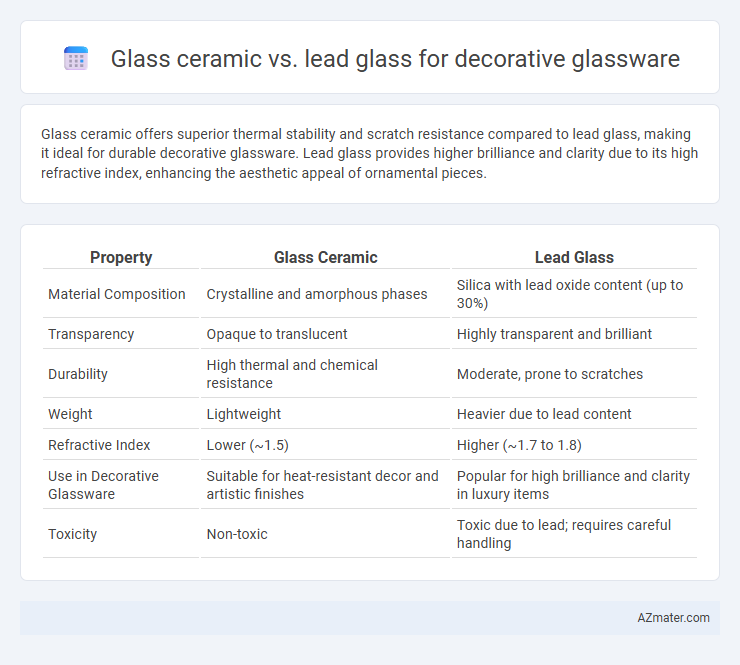Glass ceramic offers superior thermal stability and scratch resistance compared to lead glass, making it ideal for durable decorative glassware. Lead glass provides higher brilliance and clarity due to its high refractive index, enhancing the aesthetic appeal of ornamental pieces.
Table of Comparison
| Property | Glass Ceramic | Lead Glass |
|---|---|---|
| Material Composition | Crystalline and amorphous phases | Silica with lead oxide content (up to 30%) |
| Transparency | Opaque to translucent | Highly transparent and brilliant |
| Durability | High thermal and chemical resistance | Moderate, prone to scratches |
| Weight | Lightweight | Heavier due to lead content |
| Refractive Index | Lower (~1.5) | Higher (~1.7 to 1.8) |
| Use in Decorative Glassware | Suitable for heat-resistant decor and artistic finishes | Popular for high brilliance and clarity in luxury items |
| Toxicity | Non-toxic | Toxic due to lead; requires careful handling |
Introduction to Decorative Glassware Materials
Glass ceramic and lead glass are prominent materials in decorative glassware, each offering unique properties. Glass ceramic provides high thermal resistance and durability, making it ideal for intricate designs that require strength and stability. Lead glass, known for its high refractive index and brilliance, enhances light dispersion, resulting in exquisite clarity and sparkle for ornamental pieces.
Overview of Glass Ceramic
Glass ceramic is a versatile material characterized by its crystalline microstructure formed through controlled heat treatment, offering superior thermal shock resistance and mechanical strength compared to lead glass. Unlike lead glass, which contains lead oxide enhancing weight and brilliance but posing environmental concerns, glass ceramic provides enhanced durability and chemical stability, making it ideal for decorative glassware exposed to varying temperatures. Its ability to combine aesthetic appeal with functional performance makes glass ceramic a preferred choice for elegant yet practical decorative pieces.
Overview of Lead Glass
Lead glass, also known as lead crystal, contains a high percentage of lead oxide, typically between 18% and 40%, which enhances its refractive index and brilliance, making it highly prized for decorative glassware. This type of glass offers superior clarity, weight, and a distinctive sparkle compared to glass ceramics, making it ideal for luxury items such as fine glassware and ornamental pieces. Lead glass is softer and more easily engraved or cut, allowing intricate designs that add aesthetic value to decorative glassware collections.
Aesthetic Properties: Clarity and Color
Glass ceramic offers a unique combination of translucency and subtle opalescence, creating a sophisticated matte finish that enhances intricate patterns without glare. Lead glass, known for its high refractive index, provides exceptional clarity and brilliance, resulting in vibrant colors and sparkling brilliance that highlight decorative details. The choice between glass ceramic and lead glass depends on whether the desired aesthetic emphasizes muted elegance or vivid, dazzling clarity in decorative glassware.
Durability and Strength Comparison
Glass ceramics exhibit superior durability and strength compared to lead glass, making them ideal for decorative glassware subjected to frequent handling. The crystalline structure of glass ceramics provides enhanced resistance to thermal shock and mechanical stress, whereas lead glass, while prized for its brilliance and clarity, is more prone to scratching and chipping. Consequently, glass ceramics offer long-lasting performance and maintain aesthetic appeal in demanding environments better than traditional lead glass.
Workability and Design Flexibility
Glass ceramic offers superior workability for intricate decorative glassware due to its ability to withstand rapid temperature changes without cracking, allowing for complex shapes and detailed designs. Lead glass, prized for its high refractive index and clarity, provides excellent design flexibility through easy cutting and engraving, though it requires slower cooling rates to prevent stress fractures. Designers often choose glass ceramic for durability and intricate detailing, while lead glass is favored for brilliance and ease of fine surface work.
Health and Safety Considerations
Glass ceramic offers superior health and safety advantages over lead glass for decorative glassware due to its non-toxic, lead-free composition, eliminating the risk of lead leaching into food or beverages. Lead glass, containing significant amounts of lead oxide, poses potential health hazards, especially with prolonged contact or use in food-related items, raising concerns over lead poisoning. Regulatory standards increasingly restrict lead content in consumer products, making glass ceramic a safer and more compliant choice for decorative applications focused on health-conscious consumers.
Cost and Market Value
Glass ceramic offers higher durability and thermal resistance, making it more expensive but valued for premium decorative glassware. Lead glass, known for its brilliance and lower production costs, dominates the market due to affordability and aesthetic appeal. The cost differential influences market value, with lead glass favored for mass-market products while glass ceramic targets niche segments seeking longevity and heat resistance.
Environmental Impact and Sustainability
Glass ceramic offers a lower environmental footprint compared to lead glass due to its longer lifespan and greater recyclability, reducing waste and resource consumption. Lead glass contains toxic lead oxide, which poses significant environmental hazards during production and disposal, complicating recycling efforts. Choosing glass ceramic for decorative glassware supports sustainability by minimizing hazardous materials and enhancing eco-friendly manufacturing practices.
Choosing the Right Material for Decorative Glassware
Glass ceramic offers exceptional thermal resistance and durability, making it ideal for decorative glassware exposed to temperature fluctuations. Lead glass, known for its brilliance and clarity due to high lead oxide content, enhances aesthetic appeal but is less suitable for functional pieces that require toughness. Selecting the right material depends on balancing visual elegance with practical strength and safety requirements for the intended decorative use.

Infographic: Glass ceramic vs Lead glass for Decorative glassware
 azmater.com
azmater.com